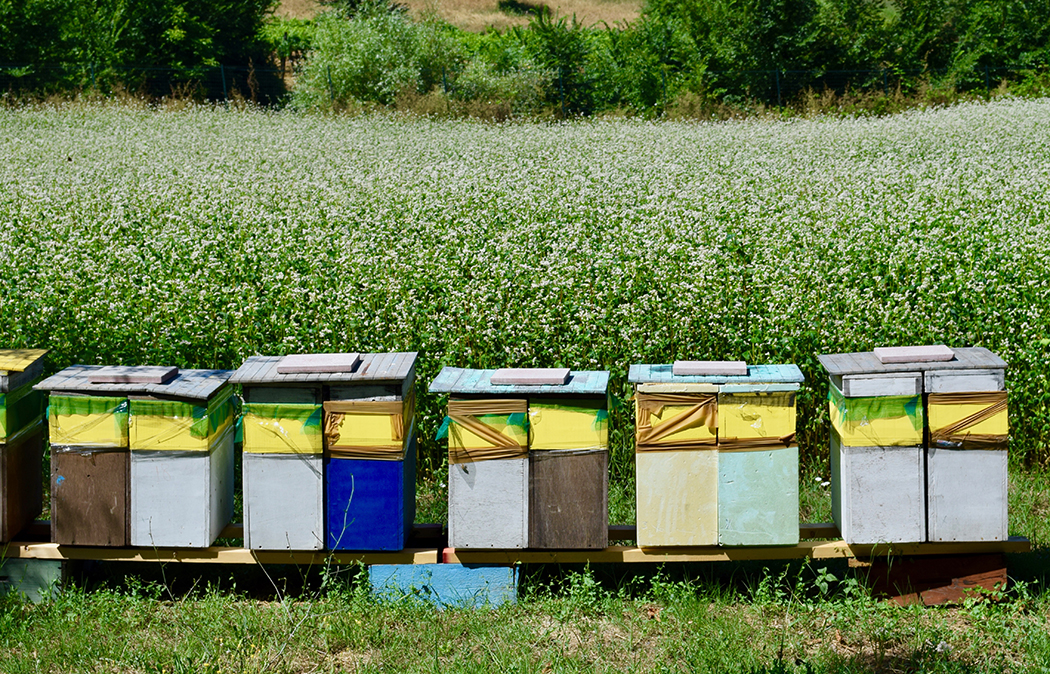Do you know that buckwheat is not a wheat?
We learned this by going to photograph the buckwheat plantations last July and to our surprise we found ourselves faced with a field of white flowers with millions of bees. The fields were cultivated by the Cooperativa Terre Sane and the president Vincenzo Venditti told us that they had calculated they have about 5 million bees in all the crops that they managed.
Next to the field of the hives they confirmed the presence of the insects with their buzzing filling the air with a special music.
Buckwheat does not belong to the family of cereals but to that of polygonaceae and for this it is gluten-free. Perhaps the name of the family derives from its strange pyramid shape with many sides. While the name Saraceno is said to be due to the fact that it was brought to Italy by the Turks who were called Saracens.
Also this plant, like many others, is native to Asia and for centuries has been cultivated in the mountain areas of Trentino and Valtellina. In fact it is a fundamental ingredient of some of their typical dishes such as Pizzoccheri and Polenta of Taragna.
Buckwheat is rich in minerals such as magnesium (but also manganese, copper and phosphorus), B vitamins, and E, proteins and fibre. But this plant tells not only the story of a food capable of helping those suffering from diabetes, hypertension and even cancer. Today buckwheat also tells stories of cultural redemption that then became a social redemption.
In recent decades, the industrialization of agriculture and the monopoly of a few multinationals had led to the end of biodiversity and enriched our tables with flours added with gluten and with the presence of chemical reagents such as glyphosate. It is no coincidence that there has been an exponential increase of some diseases both in the cultivation areas of these plants and among the regular pasta consumers.
The return to natural agriculture by many people, with a high degree of education on the one hand, and of informed consumers on the other has led more and more to change the cultivations of small entrepreneurs.
To combat the excessive power of the multinationals that establish the price of wheat in an agricultural commodity exchange, controlling the fair play of the market has led to the rediscovery of ancient grains that did not follow the logic of the market.
So new farmers approached their fields and started cultivating ancient grains and growth rules that were being lost. Senatore Cappelli and also buckwheat are back to becoming familiar names to us consumers. Obviously they are all organic crops, even homeopathic.
As consumers, then, we no longer have the nose ring leading us and we want to know who cultivates the fields. We want the name and surname of who provides us with the raw materials and products that end up on our table.
So we went to Ripi and we discovered that buckwheat is not a wheat, we heard the story of the Terre Sane cooperative that has begun to cultivate small fields scattered around the hills of this charming corner of Ciociaria and many other towns.
They took us to the spelled fields of Esperia, Atina and other towns of this incredible area which is Ciociaria.
A difficult job with the hidden dream of recreating a landscape made of cultivated fields that can also be able to give new harmony to the territories. To get new visitors. Places that can make young people want to take care of their town and not abandon it in search of fortune abroad.
Buckwheat is then the first step in a lifestyle, a lifestyle that unites producers and consumers in the rebirth of their territories. What is needed now is to spread this awareness more and more, for many to dream because dreams come true.
And if they had not come true for us, it would have had a different meaning. Now, we will have fun together eating watermelon after the harvest, in village festivals, taking pictures, telling about it and ... eating it together at the table!
The history of the miller and the recipes will come in the next story.









Follow us